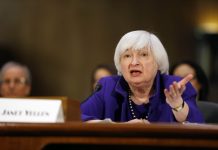
Buying a home has gotten much more expensive lately as mortgage rates’ rise continues unabated.
Home loan rates have been on a tear the past eight weeks, climbing to heights not seen in more than two years. According to the latest data released Thursday by Freddie Mac, the 30-year fixed-rate average jumped to 4.3 percent with an average 0.5 point. (Points are fees paid to a lender equal to 1 percent of the loan amount.) It was 4.16 percent a week ago and 3.96 percent a year ago.
The 30-year fixed rate, the most popular mortgage product, hasn’t been this high since April 2014. It has risen 83 basis points since Oct. 27 and 14 basis points in the past week. (A basis point is 0.01 percentage point.)
The 15-year fixed-rate average spiked to 3.52 percent with an average 0.5 point. It was 3.37 percent a week ago and 3.22 percent a year ago. The 15-year fixed rate hadn’t cracked 3.5 percent since January 2014.
The five-year adjustable rate average grew to 3.32 percent with an average 0.4 point. It was 3.19 percent a week ago and 3.06 percent a year ago.
“A week after the only rate hike of 2016, the mortgage industry digested the Fed’s decision and this week’s survey reflects that response,” Sean Becketti, Freddie Mac chief economist, said in a statement. “Following Yellen’s speech last Wednesday, the 10-year Treasury yield rose approximately 10 basis points. The 30-year mortgage rate rose 14 basis points to 4.30 percent, reaching highs we have not seen since April 2014.”
Mortgage rates’ steady upward march reflects the surge in long-term bond yields. The yield on the 10-year U.S. Treasury peaked at 2.6 percent last week before retreating slightly. The movement of the 10-year bond is one of the best indicators of whether mortgage rates will rise or fall. When yields go up, home loan rates tend to also go up.
But the coming holidays may slow mortgage rates’ ascent. Bankrate.com, which puts out a weekly mortgage rate trend index, found that more than two-thirds of the experts it surveyed believe rates will remain relatively unchanged in the coming week, moving less than two basis points up or down.
“With many traders off for the Christmas holiday, we aren’t seeing much movement in Treasury yields, and mortgage rates have also been stable this week,” said Michael Becker, branch manager of Sierra Pacific Mortgage in White Marsh, Maryland. “With the combination of the holiday and a lack of economic data coming out over the next week, I don’t think we will see much movement this week. Mortgage rates will be flat in the coming week.”
Meanwhile, mortgage applications reversed course this week, according to the latest data from the Mortgage Bankers Association.
The market composite index – a measure of total loan application volume – rose 2.5 percent from the previous week. The refinance index increased 3 percent, while the purchase index also increased 3 percent.
The refinance share of mortgage activity accounted for 57.9 percent of all applications.
“Last week, mortgage rates increased to their highest level since May 2014, at least partially due to Federal Reserve’s widely anticipated rate hike and strong signaling of multiple additional rate hikes in 2017 and beyond,” said Mike Fratantoni, MBA’s chief economist. “Despite the increase, refinance application volume reversed a 10-week trend and increased slightly, most likely due to borrowers moving to submit applications ahead of the Federal Reserve action. Purchase activity also increased, but remains skewed towards the higher end of the market, as the average purchase loan size was at its second highest level in the history of MBA’s survey.”
(c) 2016, The Washington Post · Kathy Orton
{Matzav.com}











